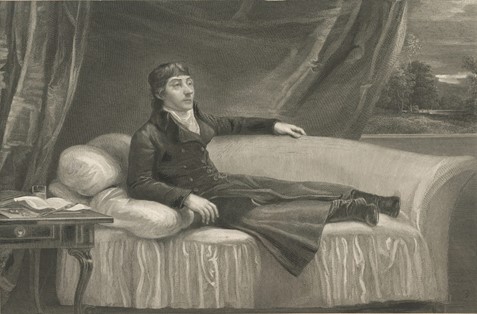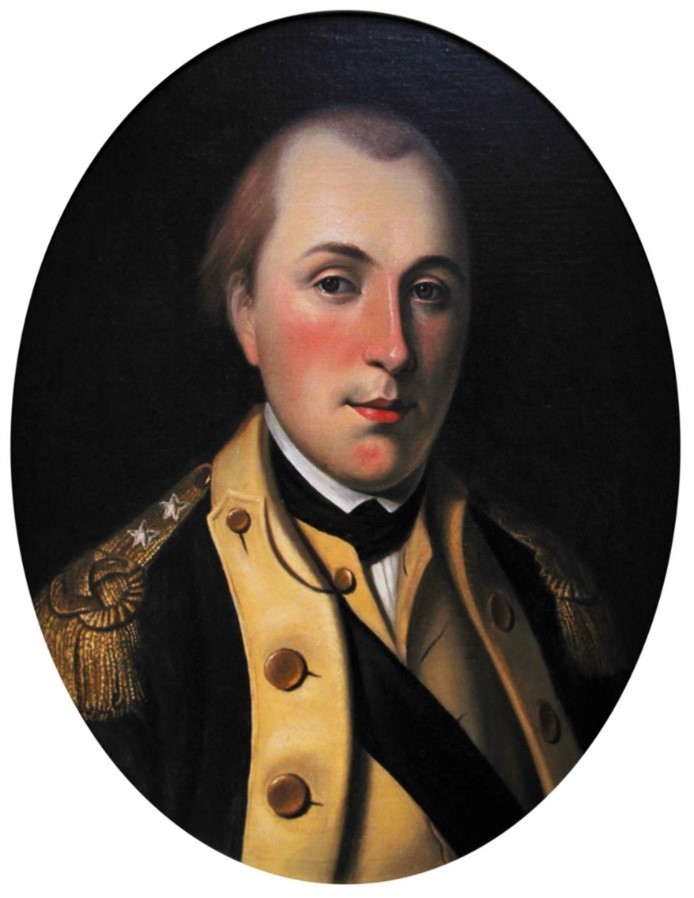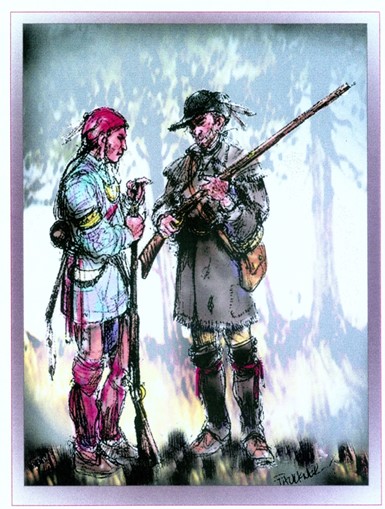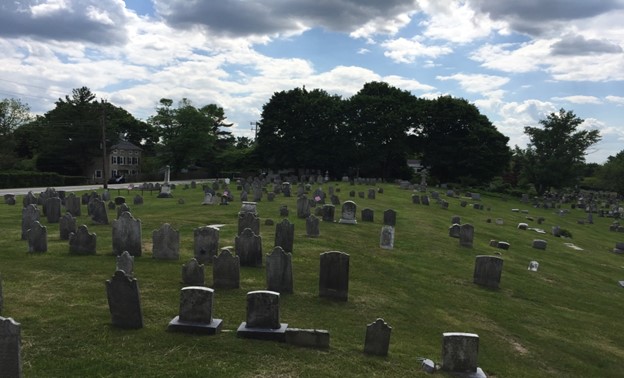Fort Schuyler 2d April 1778.
Honord Sir, With this you have a State of this Garris, with a return of the Ordinance Stores wanting to Compleat the ordinance here…Marquis Le Feiatt has sent an Engineer to the Onida Castle with a Speech to the Onidas & Tuscarorars previous to a promise they made him at the Treaty at Johnston, inviting 300 - of their young Warriors to come down to Albany & Join him, which if they do , he means with them to Join Genl. Washington , as soon as Possible ; -- by a Letter from the Engineer (one of Lafayette’s officers) to Col. Willett yesterday, he informs him that Indians are Determind to join the Marquis, as soon as a Small Piquet Fort is Compleated which he is now at work upon at Onida to secure the families of those & the other Indians who stay behind, in case the Senecas shou'd make any attempts against them , -- there is 200 of this County Militia to go to Ondia in a few days to help to build the Fort, which will enable the Indians to go down soon. Shou'd the Marquis be able to get the Indians down as far as Head Quarters, it is thought it may Answe some good purposes, especially in ambushing the Enemies Forraging Parties, and stop them in some measure from committing so many Depreditions in the Country, -
Geo. I. Denniston.
Ensign Denniston’s somewhat gossipy letter to New York Governor George Clinton about goings-on around Fort Schuyler (Stanwix) actually details several events that would have important impacts on the American Revolution. The Marquis de Lafayette was not in the Mohawk Valley on a whim. He had been sent to Albany by the newly reconstituted Board of War. Many of the board’s members, including the president, General Horatio Gates, no longer trusted in Washington’s ability to lead the Continental Army. Rather than attempt to replace him, however, the board maneuvered to wrest all policy-making power from Washington and leave him as a figurehead commander in chief. The brainchild of Gates, the board forwarded an overly optimistic plan to launch a large-scale raid into Canada. While giving the command to a French officer would mean that the French-Canadians would respond more favorably to the operation, the board had additional motives in mind. They assigned one of their supporters, General Thomas Conway, to be Lafayette’s second in command. The board’s true intent was much the same as what they were attempting to do to Washington: Conway would assume full command of the invasion and Lafayette would simply be a figurehead to gain French-Canadian support.

An engraving of General Thomas Conway reclining on a couch.
The board however, had not counted on Lafayette’s loyalty to Washington being far stronger than any desire for fame and glory. Knowing that the board had directly snubbed Washington, Lafayette refused to enter fully on the expedition without Washington’s support (the board had belatedly notified Washington of the Canadian plans and had not sought his advice or input in any way.). Also knowing Conway’s “political leanings”, he objected to Conway being his second in command. In the end, Lafayette needn’t have worried about any of it.
Lafayette arrived in Albany on February 17 to find that little to nothing had been done to gather men and supplies, and as time dragged on, members of congress began questioning the operation’s merits. Perhaps worst of all, it appeared the British had full knowledge of the plan. In a letter to Washington, Lafayette fumed “I am sent, with a great noise, at the head of the army to do great things. The whole continent, France, and what is the worst, the British army will be in expectation.”
While Lafayette waited for the final decision concerning the expedition’s fate, he attended a conference between the American Indian Affairs representatives and representatives of the Six Nations in Johnstown on March 5th. Lafayette was there to present Washington’s request that the Oneida and Tuscurora Indians send 300 warriors to join his army at Valley Forge. With the British occupying Philadelphia, he thought the Indians would be perfect not only for scouting missions, but for ambushing British patrols and foraging parties coming out of the city. Ensign Denniston’s letter mentions Lafayette’s “second call” to the Oneida and Tuscarora and their determination to join Washington once a small fortification had been built in one of their villages to help defend it from attack. The Canadian operation was finally canceled on March 13th and Lafayette returned to Washington’s army later in April. Eventually, after much astute political counter-maneuvering by Washington and his supporters, his position as de facto commander in chief in all operations of the army would be confirmed by congress.
 A painting of General, the Marquis de Lafayette.
A painting of General, the Marquis de Lafayette. While Lafayette’s engineer laid out the lines for the “Small Piquet Fort” for the Oneidas mentioned in Denniston’s letter, Both Colonel Gansevoort at Fort Schuyler (Stanwix), and Colonel Klock of the Tryon County Militia, pleaded a lack of sufficient men to work on the “Piquet Fort” and it would not actually be built until the following year.
Despite the promised fort not being built, the Oneidas still assembled 47 warriors to join the Continental Army at Valley Forge. This included the Oriska war captain Hon Yerry, who had fought at Oriskany along with his wife Two Kettles. The Oneidas arrived at Valley Forge on May 15th and Oneida oral tradition states that the Oneida contingent also brought a supply of corn with them to help feed army.
The Oneidas’ major contribution to Washington’s forces occurred on May 20th at the Battle of Barren Hill. Washington had detached a large reconnaissance in force to harass the British in Philadelphia and learn of their movements. Commanded by Lafayette, the American force, including the Oneida warriors, set up defensive positions within two miles of the British outposts. Unfortunately for Lafayette, the British had been informed of the American operations and planned a surprise attack to destroy Lafayette’s force.

On the morning of the 20th, the Oneidas were part of a mixed scouting force of cavalry and infantry. Hearing the sounds of approaching British calvary, the Oneidas quickly set up an ambush. The French volunteer officer overseeing the Oneida’s operations, Louis de Tousard, later reported to Congress that “I have had the occasion to aquaint the British light horses with the hallow of the Indians and their hability in firing”. Caught completely by surprise, the British cavalry fell back and the American force began a withdrawal back to Lafayette’s main force, unaware of the potential trap they were in. Luckily, effective scouting and intelligence gathering by Lafayette had appraised him of his dire situation and as the Oneida retreated, Lafayette’s whole force was moving to escape the trap. This situation however, meant that for a time, around fifty Oneida and French volunteers became the rear guard against 2000 British infantry and calvary. Due in part to the Oneidas’ stubborn retreat, Lafayette’s whole force escaped with minimal casualties. While no official records were kept of the Oneidas’ losses, church records at Barren Hill indicate that six Oneidas were killed in the battle and at least four were interred in the churchyard. A plaque was later placed in the churchyard to commemorate their sacrifice. The British claimed to have captured two Oneida. One of them, Jacob Skayowi:yo:h (English name: Beautiful Sky), was paraded through Philadelphia stripped of everything but his breechcloth.

The burial ground at Barren Hill. At least 4 of the six Oneida killed in the battle are believed to be buried here.
With the British soon to abandon Philadelphia, the need for the Oneidas’ special skills became less, and coupled with their concern over the safety of their villages, all the Oneida returned home by the end of June.
Thus concludes the substance of Ensign Denniston’s letter to the governor. While his intent was simply to relate the latest interesting news to a friend, Denniston’s letter is actually a brief introduction to some events that either had or would have a significant impact on the war.
